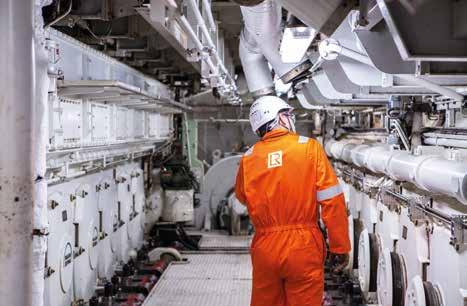
10 minute read
GYG Ltd ‘stronger than ever’ despite leaving AIM
Remy Millott, CEO of GYG, provides insight on the decision to de-list from the Alternative Investment Market of the London Stock Exchange.
BY MAX STOTT
GYG Ltd, the superyacht painting, service and supply company, recently de-listed from the Alternative Investment Market (AIM) and returned to life as a private company. Despite trading in the first half of 2022 being in line with market expectations, and delivering a strong EBITDA performance (earnings before interest, taxes, depreciation and amortization), a variety of factors meant that the cost and inconvenience of being publicly listed were no longer generating sufficient benefit for the company.
Valuation volatility, geopolitical factors and the compatibility of the requirements for transparency within public markets and clients’ discretion were the main contributing factors influencing this decision.
Although the Covid pandemic significantly affected the majority of businesses listed on AIM, GYG was one of the few companies that was able to maintain operations and report impressive revenue growth and profitability throughout the period. However, despite this recent display of strength during a period of uncertainty, external influences and geopolitical tensions in Europe over the past six months meant that many businesses in the yachting industry were forced to reassess and adapt.
The sensationalist and predominantly negative press coverage surrounding the superyacht market following the sanctions fall-out meant that companies such as GYG suddenly became less appealing to potential investors in a very short space of time.
Remy Millott, CEO of GYG, explains, “There was a lot of negativity regarding any company that worked in an industry that might have an association with Russia. So we decided to take a step back and take stock and we are very confident this was the right decision for our business.
“Typically, when you de-list a company, the share price falls off a cliff and everyone runs for the hills. In our case, 98 per cent of our shareholders voted to maintain their shareholding in GYG as a private business and that’s because they still recognise the substantial opportunities and they still like the business.”
Millott adds, “Ownership is now concentrated amongst management and three global institutional investors and we have received a lot of interest from people in the industry who want to buy shares in GYG. At the moment, the company is stronger than ever, and we have a lot of firepower at our disposal, so we are excited to start this new chapter.”
Unfortunately, for most publicly listed companies in the superyacht industry, strict NDA contracts typically tend to prevent stakeholders from being fully transparent with the public market. For example, once a major contract is signed for a large new build, only certain details, such as the name of the shipyard and the LOA of the vessel, will be made public.
Other information, such as the name of the yacht and the identity of the ultimate beneficial owner, must be kept private. This massively downplays the significance of any share-price news updates being communicated through a stock exchange announcement.
With GYG Ltd no longer having to comply with onerous regulatory requirements, the focus now will be on expanding the business in the most sustainable and cost-effective manner possible. Millott hinted that over the next couple of months there will be an array of excit-ing announcements showcasing the company’s intent to strengthen its green credentials while continuing to deliver the highest quality service in the market.
“Right now, the priority for me isn’t about how much revenue we are doing, it is about the quality of the earnings for the group,” says Millott. “Our goal is to deliver the best quality and the best service for the best yachts on the market. I feel that we already have the best reputation quality-wise, but we want to build on that and maintain it while we make the most of our expansion opportunities.”
While this move is a testament to the company’s ability to adapt and recalibrate in an uncertain and everchanging market, it also reveals the true breadth of the challenges facing even the most reputable companies in the superyacht industry today. MS

Photo: © Stuart Pearce
Remy Millott, CEO, GYG.
‘Refit is a hard job … but we’re here to help’
Lloyd’s Register surveyor Wilfredo Cedeño shares his experience and offers advice for superyachts contemplating a major refit.
With 19 years’ experience as a Lloyd’s Register surveyor, and a career bridging the passenger, shipping and yachting sectors, Wilfredo Cedeño has seen the industry evolve. A major refit is one of the most significant challenges that a yacht will face in its lifetime, and navigating the regulations and shipyards while also attempting to meet an owner’s ambition is extremely challenging.
As many captains, engineers and senior crew can attest, a Class survey can be daunting. Acknowledging this, Cedeño says, “Refits can be confusing for captains, crew and managers. There has been the change from LY1 to LY2 and LY3 [Code of Practice for the Safety of Large Commercial Sailing and Motor Vessels] in recent years. On top of that we have every other individual flag with their own codes to consider. You may very well feel you need a lawyer relatively quickly! Regardless of whether you feel you need to go this far, my advice is to certainly have somebody involved who is conversant with all of the codes.”
“The best place to start is with what we at Lloyd’s Register consider a refit.”
“Many superyachts will use the time of a special survey, such as a five-year, to complete some works and then call it a refit. There is no issue with this. However, for us, a refit is a modification, upgrade or a major structural change. For example, an owner may want to take their boat to polar regions or increase the passenger capacity, or they may want to increase the generator capacity because they realised over the summer that they did not have enough air conditioning!”
The refit, as defined, leads to modifications that can affect a vessel’s compliance and this is where many may find themselves on the dreaded wrong side of a non-compliance. To this point, Cedeño stresses the need for foresight and to keep one key question in mind:
How does what the works being undertaken affect compliance?
“This is the key consideration when you are doing a major refit: how is this going to affect the compliance with regulations? This may sound simple but many operators are not aware of the downstream consequences of modifications. It’s not just a case of showing up to port and getting in touch with a surveyor.
“The most important advice that I would give to help with this is to appoint a project manager. A major refit must be treated as a project much like a new build, and managed as such. For a captain on a 34-metre this may all be manageable with their workload, but for large yachts, aligning this level of works is a big undertaking and can be very timeconsuming and costly. Having someone who is fully conversant in the regulations involved in the project is very important.”
The workload associated with a major refit can become excessive for a busy crew. Failure to consider the myriad variables that make up a major structural change and its associated classification process can be extremely costly, in terms of both time and money.

Cedeño highlights that, in his experience, superyacht refits tend to be approached in a relatively ad-hoc manner compared to other marine sectors. Lloyd’s Register, as with the majority of reputable classification societies, has an extensive network of offices and expertise worldwide, and, as Cedeño explains, superyacht refits may require coordination across borders and departments.
How does a project manager benefit a major refit?
“I come from a commercial cargo background, where a refit is a major undertaking and is taken very seriously,” says Cedeño. “The coordination of so many different departments, and the tight timeframes, make a project manager imperative. A project manager can also be a point of contact with the Lloyd’s Register Client Facing Office (CFO). We have our offices around the world with different specialisations. Major refits may need the input from many of them at once. A project manager, in close contact with us, can manage this ahead of time.
“We are working on a superyacht refit project now where the yacht had booked two months in a shipyard, which, when our surveyor arrived, was also the first time that we saw any of the drawings. Very quickly we have had to tell the captain and management that they will be out of the water for at least this winter, if not longer. This could have been anticipated and managed with a project manager and efficient forward planning.”
As a surveyor with experience across the marine industry, what are some of the common trends and common oversights that you are seeing concerning superyacht refits?
“A common major modification for us now on larger yachts is the installation of a ballast-water-treatment plant. However, this is not the same as installing a refrigerator! On yachts in particular, where space is at a premium, these systems will be installed in an area that had another purpose. We will have to covert a storage space into a technical space. We see yachts showing up in port and seeking approval on the spot for a modification like this, which is not realistic.
“There are some things that we obviously see only on yachts, and they can be fun projects: yachts wanting to retrofit a jacuzzi on the sundeck and forgetting the stability considerations of putting four tonnes of water that high; yachts extending the transom for a new beach club but not considering the effect on rudder position and turning radius; vessels replacing the interiors and going commercial but not thinking to change the insulation that now must meet a different standard. All of these unique requests can be addressed and approved, but it is much easier with early communication and project management.”

What advice would you give a superyacht in selecting a shipyard for a major refit?
“Many larger yachts are returning to the new-build shipyards, like Lürssen and
Oceanco, for major refits. This is great from a project-management perspective as these yards have the teams in place. We see issues arising when yachts head to places like STP and Navantia, to give examples from Spain, expecting this same level of project management.
“These yards are very good at what they do, they will expertly put the vessel on the hard stand and work with the captain and engineer to accommodate the works. However, you will need to approach them with the exact set of specifications and instruct them exactly what you would like to have done. This leaves room for non-compliance with Class if there is not a project manager or person in communication with us.”
Do you feel that there is enough appreciation and understanding of Class during major refits?
“In general, we find that there isn’t a deep understanding of the regulations. But that is okay, I don’t blame the operators or the shipyards for this. That is what we are here for. We spend a lot of our time at conferences and technical forums to stay ahead of all of these changes and modifications to regulations.
“My final piece of advice would be to never underestimate a refit. We should always think ‘What is the engineering perspective? What is the safety perspective? What is the stability perspective?’. It’s very common to not understand the full implications of refit, and I would be hesitant to blame a shipyard or a crewmember for missing something. It’s a hard job and it needs to be taken seriously, but we are here to help.”










